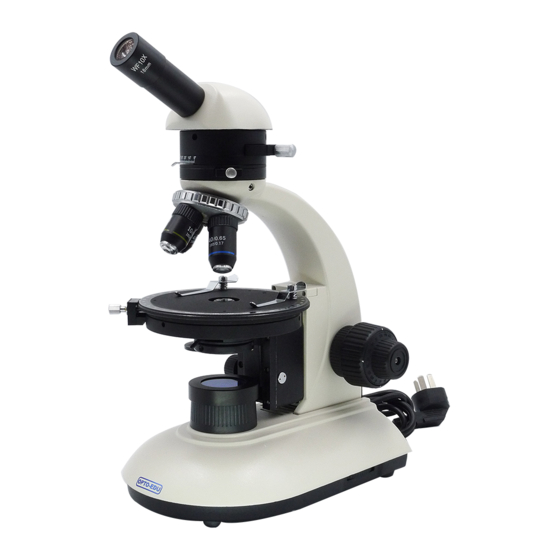
Summary of Contents for OPTO-EDU A15.2604
- Page 1 A15.2604 Polarizing Microscope To ensure the safety and obtain satisfactory performance, please study this instruction manual thoroughly before start to use the instrument.
- Page 2 ATTENTIONS 1. Disassembly only by the professionals. The microscope has been adjusted before shipping, Unprofessional-person should not disassemble and remove any other parts. If you have any questions, please contact with manufacturer or local distributor. 2. Note the input voltage if identical with operating voltage of instruction.
-
Page 3: Table Of Contents
CONTENTS 1. Purposes ......................5 2. Performance ..................... 5 3. Installation and use ..................6 3.1 Installation ...................... 6 3.2 Operation ......................7 3.2.1 Electric component ................. 7 3.2.2 Place sample ................... 7 3.2.3 Condenser ....................7 3.2.4 Focusing ....................7 3.2.5 Polarizing observation ................ - Page 4 Fig.1 B-POL Polarizing Microscope Size -A 01—Monocular tube 02—λ Slip , λ/4 Slip 03—Nosepiece 04—Stage 05—Condenser 06—Filter(removable) 07—Collector 08—Base 09—Condenser lifting handle 10—Left Fine focusing knobs 11—Left Coarse focusing knobs 12—Clamps 13—Body 14—Midbody - 3 -...
- Page 5 Fig.2 B-POL Polarizing Microscope Size –B 15—Eyepiece 16—Observing tube locking screw 17—Analyzer change-over handle 18—Vernier 19—Stage locking screw 20—Aperture diaphragm handle 21—Polarizer unit 22—Potentiometer knob 23—Right Coarse focusing knobs 24—Right fine focusing knobs 25—Tension adjusting handle 26—Locking screw for midbody 27—Switch slip for Bertrand Lens - 4 -...
-
Page 6: Purposes
1. Purposes This transmitting polarizing microscope is designed on the basis of biological microscope ,use the polarization of light to make microscopic observation for double refraction material. It is widely used in geology, chemical industry ,metallurgy, semiconductor, petroleum, spinning field etc, also play important role in biological, phytology, pharmacology, pathology field etc. -
Page 7: Installation And Use
2.3.6.Rotatable stage: Diameter Φ142mm,360° uniform scale ,division 1°,vernier division 6′. With high precision bearing construction , rotatable stage has been reset before factory ,polarizing attached mechanical stage is optional . 2.3.7. Focusing unit: Coaxial Coarse And Fine Focusing Knobs, Coarse stroke 22mm, up position is optional;Fine division 2µm, Condenser up-down range 25mm. -
Page 8: Operation
3.1.8 Please connect main body with power line if in detachable power supply. ▲Make sure all items taken out before deposal packing case. ▲Nosepiece should be rotate by wrenching the outer gear rim. ▲handle gently during installation, especially don’t touch lens. ▲For the protection of the environment, please properly handle the microscope packing waste. - Page 9 b. Put the up analyzer in good position and rotate to 0°,then analyzer and polarizer should in orthogonal position, field will become more darker from objective, otherwise should adjust the analyzer. You can determine mineral slice sample’s interference colors order, birefringence ,extinction type, extinction angle, elongation sign etc through orthogonal polarizing angle , Also can judge whether it’s crystal twin mineral.
-
Page 10: Use Of Tension Adjusting Handle
Conoscopic observation usually with high power objective and can clearly see the amplified interference pattern, confirm its axis and slice direction, determine mineral’s light symbol and axis angle (biaxial crystal). ▲Don’t reverse the direction forcefully for left and right coarse & fine focusing knobs at the same time ,otherwise will damage focusing unit. -
Page 11: Replacement Of Bulb
Environment of indoor temperature 0°~40°C ,and maximum relative humidity 85%. 4.2.3 Dehumidifier is suggested to be installed when microscope used in heavy humidity area to avoid fungus and mist damage instrument. 4.3 Replacement of bulb 4.3.1 Turn off power,and pull out plug . 4.3.2 Wait the bulb become cool. -
Page 12: Troubleshooting
5. Troubleshooting If there is any trouble occurs in operation, please referring to the following sheet listed some common troubleshooting resolve them or keep in touch with us or local agency. Trouble Causation Remedy Plug is unreliable Check joint again Switch on but bulb Bulb is broken Replace bulb... - Page 13 B-Pol Polarizing Microscope - 12 -...















Need help?
Do you have a question about the A15.2604 and is the answer not in the manual?
Questions and answers